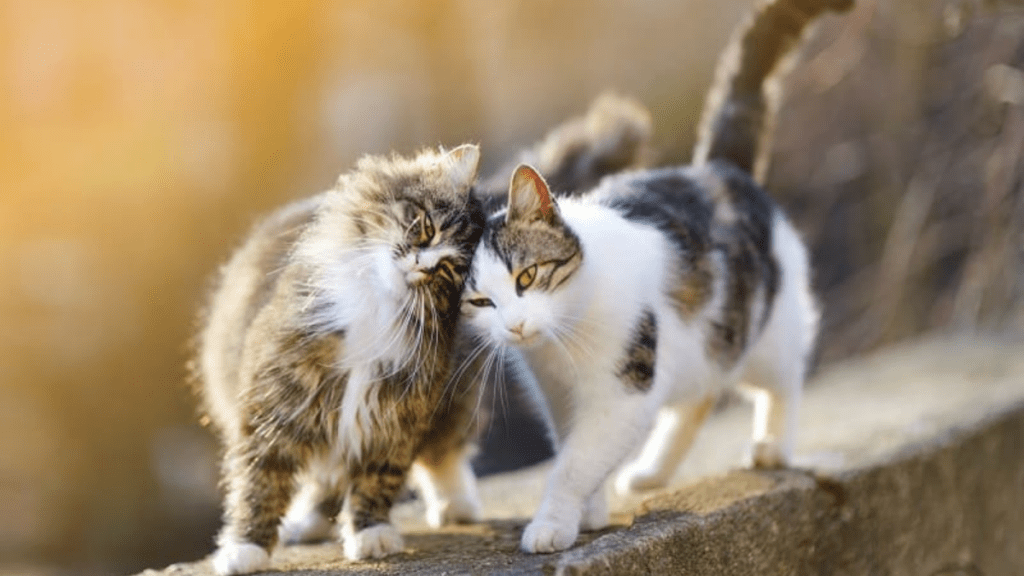Kittens will meow to their mother to let her know that they are hungry or cold, but for the most part adults don’t meow when communicating with other animals according to anthropologist John Bradshaw. Part of the evidence that Bradshaw points to is that feral cats don’t meow nearly as much as domesticated house cats. Scientists believe that the meow is a manipulative behavior that cats use to get what they want. Nicholas Dodman of Tufts Cummings School of Veterinary Medicine argues that cats learn which noises are most effective at convincing their owners to do what they want them to do. So if cats only meow at us humans, how do they communicate with each other?
It's all about body language!
Cats show affection towards each other through physical contact. They may touch noses, head-butt, or rub against each other in greeting. According to Jess Trimle, DVM of Fuzzy Pet Health, cats lick the top of other cats’ heads as a throwback to when their mother would groom and comfort them as kittens. Dr. Trimle says, “Some part of cats’ psyche recalls their time as kittens when their mother would lick them clean as they fed. When grown, cats will mimic affection with cats they’re friendly with.”
Cats give off major warning signs when they feel threatened or fearful while interacting with other cats. Agitated cats will lash their tails from side to side. You will see them look away, lick their lips, crouch down, tuck their tails, and pull their ears to the side or flatten them on their head. When cats feel threatened, they might start showing aggressive behavior. This display of aggression is a way for a cat to try to increase the distance between them, and something other cats will perceive as threatening. Cats that have reached their threshold and are on the verge of attacking will hiss and growl, flatten their ears against their heads, crouch down, and bring their forelimbs close to their hind limbs.
Feline Vocalization
Purring is one of the more common forms of feline vocalization. Many of us adore the sound of purring, and associate the noise with a content kitty. Cats will purr not only around humans but also when they are in contact with other cats, or even with objects. While most people assume that purring equates with happiness, cats will also purr when they are not feeling well or when they are anxious. Some researchers say that purring is something that cats use to self-soothe.
Less intense meows signal a confident, happy cat. Loud meowing, growling or hissing is a way that cats express anxiety and fear. A low growl, especially when made after hissing, should be taken as a warning. Cats who are feeling very fearful will often escalate their vocalization to a snarl, spit or yowl. Cats will also howl when they are in distress.
Chemical Communication
Cats also use chemical signals and marking to communicate. They rub against each other and against objects, depositing pheromones and oils from scent glands located on their foreheads, cheeks and chins. Cats will target prominent objects in the home, such as corners of walls and tables, to leave a scent trail and mark their territory.
Most people have heard of the common (and rather unpleasant) feline behavior of urinating outside the litter box. You’ve probably either experienced this with a cat in your own home, or you know someone who has. Both male and female cats can mark with urine, but intact (non-neutered) male cats are the more common culprit of urine marking. Cats spray urine to mark their territory. This behavior is mostly seen in cats who live outside or who have access to the outdoors. Cats can urinate or defecate outside the litter box for many reasons, including illness and as a reaction to an environmental stressor. Before assuming that your cat’s inappropriate urination is an unfixable problem, reach out to your veterinarian to discuss the matter further. There are many options that your vet can recommend to prevent your cat from inappropriately urinating.
~Julia R, House Paws Technician
Bradshaw, John. Cat sense: how the new feline science can make you a better friend to your pet. New York, Basic Books, 2013. January 10, 2021.
How Do Cats Communicate with Each Other? [Article] https://www.loc.gov/everyday-mysteries/zoology/item/how-do-cats-communicate-with-each-other/ January 10, 2021.
Robins, Sandy, Arnold Plotnick, Lorraine M. Shelton, and Sarah Hartwell. The original catfancy cat bible. Irvine, I-5 Publishing, LLC, 2014.
Cat Language: How Cats Communicate With Each Other [Blog Post] Retrieved from Sullin Jose. https://www.pawp.com/cat-language-how-cats-communicate-with-each-other/. September 22, 2019. January 10, 2021.
Cat Language 101: How Do Cats Talk to Each Other? [Blog Post] Retrieved from Wailani Sung, MS, PsD, DVM, DACVB. https://www.petmd.com/news/view/cat-language-101-how-do-cats-talk-each-other-37620, October 11, 2018. January 10, 2021.






